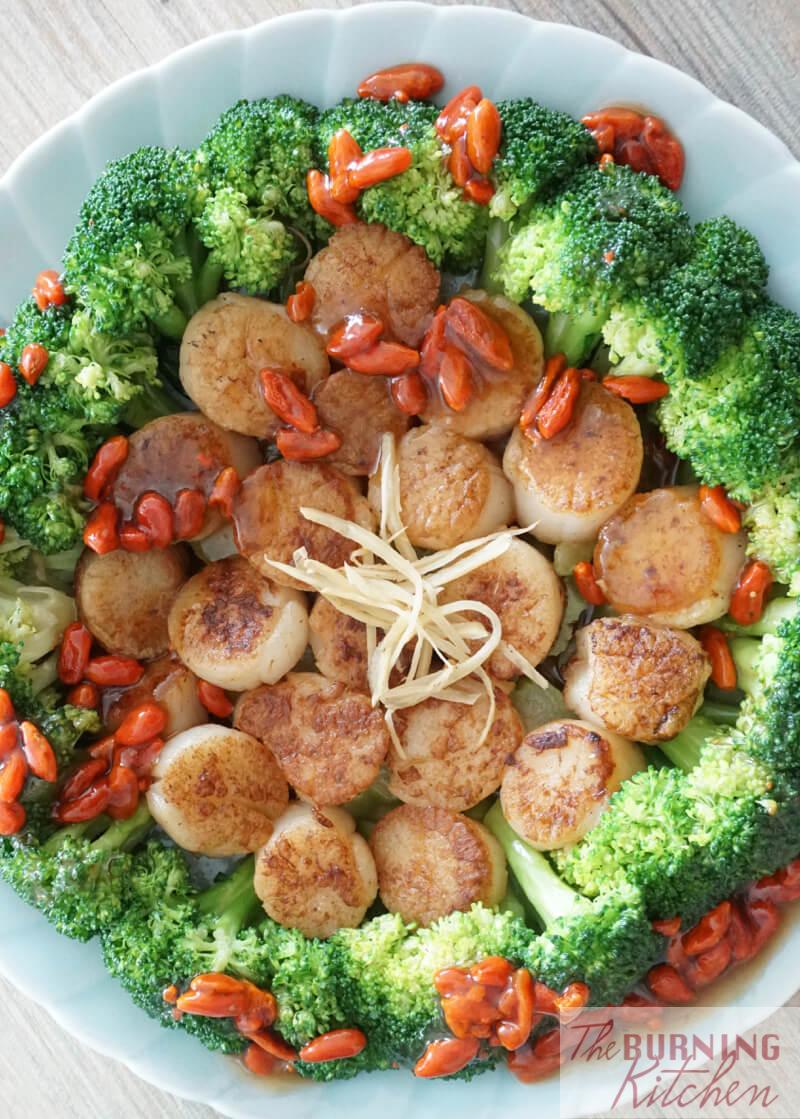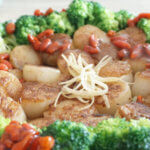Seared Scallops with Broccoli: Pan-seared golden brown scallops with stir-fried broccoli, drizzled with plump wolfberries and brown sauce.
Scallops with Broccoli was one of the dishes that I cooked during the Chinese New Year for my family and relatives. Scallops actually go really well with broccoli or other vegetables such as asparagus. It takes only 35 minutes to prepare, and its a nutritious dish to add on to any meal.

EASY NAVIGATION
1. Recipe Video
2. Step-by-Step Recipe
3. Detailed Headnotes
If you want to attempt making this dish at home, the most tricky part is searing of the scallop. If not done right, the scallop will not brown nicely, or will get stuck to the wok, and it will be such a waste. So do read the whole recipe carefully before attempting to sear the scallops.

Once you master the art of perfectly searing scallops, do also try out my recipe for Seared Scallops with Asparagus, which is another popular Chinese restaurant dish!
GRAB OUR HERITAGE HAWKER DELIGHTS COOKBOOK + EBOOK BUNDLED DEAL FOR JUST $44.85 (U.P. $54.80)
And here’s a bonus tip for you!
And If you want the broccoli to look very green and vibrant, here’s a Chinese restaurant secret that I learnt! Simply add a little bit of sodium bi-carbonate to the water used to blanch the broccoli, and you will immediately notice that the colour of the broccoli turns brighter and greener. After blanching the broccoli, rinse the broccoli with water to get rid of the sodium bi-carbonate and to stop the broccoli from cooking further. However it is not a must as the amount of sodium bicarbonate used is very little.
1. RECIPE VIDEO
Here’s the recipe video so you can visualise the steps and follow along! You may notice that we are trying out a different format for our recipe videos. What do you think?
2. STEP-BY-STEP RECIPE
Seared Scallops with Broccoli
Ingredients
- 300 gm Broccoli
- 300 gm Scallops 12-15 large scallops
- 10 gm Ginger About 4-5 slices
- 30 gm Spring Onion About 1 Sprig
- 1.5 TBsp Wolfberries Dried
Condiments
- 3 TBsp Vegetable Oil
- 1/4 tsp Sodium Bicarbonate To blanch broccoli
- 3/4 tsp Salt
Condiments for Brown Sauce Slurry
- 1/2 TBsp Oyster Sauce
- 1/2 tsp Salt
- 1 tsp Light Soy Sauce
- 2 tsp Corn Starch
- 50 ml Water
Instructions
Preparation Method (8 min)
- Cut the broccoli into bite size pieces.
- Cut the ginger into thin slices.
- Wash the spring onion and cut into 4-5 segments
- Rinse the wolfberries, drain and set aside.
- Mix all the ingredients for the brown sauce slurry and set aside.
Cooking Method (22 min)
- In a pot, blanch the scallops in boiling water for about 5 mins (set a timer). When the scallops are done, drain and pat dry.
- While waiting, add 1.5 litres of boiling water, 1/2 tsp of salt, 1/2 tbsp of oil and the sodium bicarbonate to the wok. Blanch the broccoli stems for 2 minutes. Next add in the broccoli flowers to blanch for a further 4 minutes (set timer). When the broccoli is done, remove the broccoli, rinse and drain dry.
- Heat up 1 TBsp oil in a large pan over high fire, spreading the oil all over the pan.
- Add the scallops spacing them out around the pan, and sear for about 3 minutes until the bottom turns golden. Then flip the scallops with a pair of tongs and sear the other side for another 3 mins. Remove the scallops and place on a kitchen towel to soak up excess oil.
- Wipe the wok with a sheet of kitchen towel. Add 3/4 tbsp of oil and heat over medium high fire, then fry the ginger slices for 1 minute or until aromatic.
- Add in the broccoli and 1/4 tsp of salt and stir-fry for about 2 minutes. Then remove from the wok and set aside.
- Heat adjustable]3/4[/adjustable] tbsp of oil over medium high fire, then fry the spring onions for about 1 minute or until aromatic. Next, remove and discard the spring onions.
- Give the brown sauce slurry a quick stir before add it to the wok, stirring it constantly while allowing the gravy to thicken. Once the gravy has thickened, add in the wolfberries and continue to cook for 2 mins until they plump up. You can add more water if the gravy is too thick.
- Plate the scallops and broccoli, pour the gravy over and serve with rice for a simple meal.
Nutrition
3. DETAILED HEADNOTES
A. Dietary Modifications
- Child-Friendly: No modifications needed.
- Egg-Free: No modifications needed.
- Fish-Free: No modifications needed.
- Gluten-Free: No modifications needed.
- Nut-Free: No modifications needed.
B. Nutritional Information
C. Make-Ahead & Time-Saving Tips
- Take out the scallops 24-hours before and allow to defrost on the bottom shelf of the refrigerator
- Cook the rice ahead of time, and reheat it in the microwave for about 1 minute. Alternatively, get a rice cooker with a quick-cook function that takes only 15-20 minutes to cook rice.
- Cut the broccoli and ginger ahead of time
D. FAQ and Troubleshooting Guide
[expand title=” 1. Can I skip the step of blanching the scallops?”]
There are 2 types of scallops available: dry and wet (also known as “soaked” or “treated”). Most of the scallops you can find locally at the wet versions, which have been soaked in a solution to preserve it. These scallops are using whiter in colour and more plumped up, compared to the dry version which are darker beige and smaller.
During the searing process, wet scallops tend to release lots of sticky liquid. This makes it harder to sear the scallops (as this requires dry heat). It always causes the scallops to stick to the pan. That’s why it is best to blanch the scallops first to release the excess water.[/expand]
[expand title=” 2. Why does my scallops stick to the pan during searing?”]
If you have followed my instructions to blanch the scallops, but the scallops still stick to the pan, it could be due to one of the following reasons:
a. If you are using the same pan to blanch then sear the scallop, make sure you wash the pan with soap in between. Otherwise the sticky juices released from the scallop can cause the scallop to stick to the pan.
b. If your wok, cast iron skillet or stainless steel pan is new, make sure that you seasoned it first to create a naturally occurring non-stick coating known as patina.
c. Though its tempting to try to flip the scallops to check the underside, its best to avoid moving the scallops until around 3 minutes or once you can see a nice golden sear forming.[/expand]
[expand title=” 3. I cooked the scallops for too long until they were rubbery, but I still can’t get a nice golden sear?”]
If the scallops are not turning golden brown, there are a few possibilities:
a. Insufficient heat. Scallops can only be seared at high heat, so do ensure that you are using high fire, and that the oil is well heated before placing the scallops into the pan.
b. Overcrowding. Do ensure that you are not overcrowding the pan with scallops, or placing them too close to each other. When that happens, the scallops tend to ‘steam each other’ rather than getting a nice golden sear.
c. The scallops are not dry enough. Please ensure that after blanching the scallops, that you pat them very dry with a sheet of disposable kitchen towel before attempting to sear them. Otherwise water in the pan will cause the scallops to steam rather than sear.
d. Ensure that you are adding sufficient oil to the wok/pan as this helps to achieve a nice golden (not burnt) colour. But don’t overdo this otherwise the scallops will become greasy.[/expand]
[expand title=”4. Why does my broccoli turn out yellowish rather than green?”]
Firstly, do make sure you choose broccoli that is fresh. You can read my brocolli marketing guide here on what to look out for. Secondly, adding a tiny bit sodium bicarbonate to the water when blanching any vegetable helps to retain its brilliant green colour (that is what the restaurants do). Thirdly, ensure that you don’t overcook the broccoli. Broccoli that is overcooked tend to become yellowish brown, and very limp. You want the broccoli to be cooked through but still firm and slightly crunchy. After the broccoli is done, ensure that you immediately remove the broccoli from the pot and rinse it in water. Otherwise the broccoli will continue to cook as it sits in the pot of hot water.[/expand]
